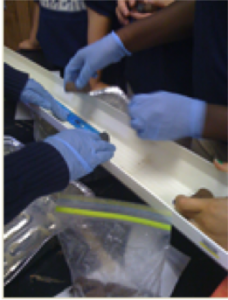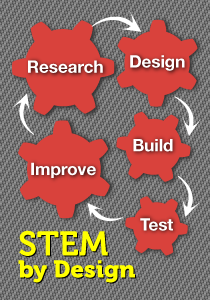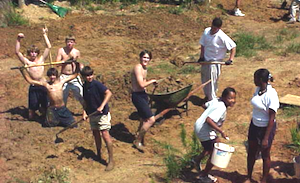6 Authentic STEM Challenges
A MiddleWeb Blog
Talk about the “odd couple.” While my husband (who is an engineer) is focusing on how he’s going to teach a Lenten series class, I (the veteran teacher) am avidly investigating the 14 greatest engineering challenges facing us today.
In case you’re as riveted by the idea of world-saving engineering challenges as I am, you can get an overview of 14 Grand Challenges identified in 2008 at the National Academy of Engineering website. (Be sure to watch the video.) They all seem critically important, but I’ll give you my Top 6.
These are the Grand Challenges that I think we can translate seamlessly into the middle school curriculum as “real problems” that students can address through STEM projects.
1. Make solar energy economical.

How might this be the kernel of a STEM lesson that introduces middle grades kids to a global need? In one middle school, teachers had students design a greenhouse for Mars. The greenhouse had to produce a maximum amount of solar energy, but students were limited in the number of solar cells they could use because of the cost of transporting solar cells to Mars. I imagine that other teachers could come up with equally intriguing problems for students to solve.
2. Provide access to clean water.
Certainly students study water from a number of different angles. This challenge radiates STEM possibilities. Middle school students address the topic of water in every grade level in one way or another. What if they set out to develop a way to supply more clean water to populations with a scarcity of water? Think of the hands-on learning! They might focus on developing a way to purify recycled water; or they might set out to design a method for reducing water usage and/or waste.
3. Manage the nitrogen cycle.

The actual problem could take on many different forms, from designing a way to apply fertilizer more efficiently, to creating barriers to the erosion that carries much of the nitrogen fertilizer away from plants and into groundwater and surface water. In two middle schools I know of, students developed barrier systems to prevent the rate of sediment erosion in stream beds. A similar approach might be taken to prevent the erosion of fertilizers.
4. Engineer better medicines.
Since human health is studied in some depth in middle school, this topic also has possibilities as an STEM challenge. A wise and creative teacher might come up with a STEM lesson that involves students in developing a “medicine” to meet certain criteria, such as diffusing through a thin material that represents human tissue. In several middle schools, students worked to solve a different type of medical problem – they developed a “clot catcher” to capture blood clots before they could reach the lungs in a model inferior vena cave. The field of medicine presents many STEM lesson possibilities.
5. Engineer the tools of scientific discovery.
I like the opening sentences of this challenge. “In the popular mind, scientists and engineers have distinct job descriptions. Scientists explore, experiment, and discover; engineers create, design, and build. But in truth, the distinction is blurry. In the century ahead, engineers will continue to be partners with scientists in the great quest for understanding many unanswered questions of nature.”
This may be my favorite challenge because it has so many possibilities for middle school students. What do we need to discover about human health, methods of studying the brain, or the universe beyond us? What mysteries remain to be discovered, and what sort of model tools might a middle school student design to investigate these?
6. Restore and improve urban infrastructure.
This challenge deals with such problems as storm water runoff, wildlife habitat improvement, aesthetic landscapes, and permeable pavements. One of my most memorable STEM projects involved partnering my 8th grade students with a university professor, Dr. Kevin White. We were in a brand new school, and the new construction, especially the pavement, was creating serious runoff problems. Guided by Dr. White and some of his engineering students, my 8th grade students identified the best location on campus to construct a wetland to filter some of this runoff.
This semester-long project involved students clearing the area, researching and planting plants to help with the sediment control and filtering, and building a weir to slow down the flow of the water through the wetland. If you’d like to see the real value of this for the students (some of whom were strugglers), you might take a look at this short article I wrote for an issue of the U.S. Department of Education’s Community Update newsletter, back in 2000.
Prepare now for the grand challenges to come
To tell the truth, finding solutions for the problems we face and successfully navigating these engineering challenges must begin early on. If our middle school students can learn how to think like engineers – how to identify and solve problems systematically – this can revolutionize how they tackle assignments, projects, obstacles, and personal problems. And they will certainly be better prepared to enter the workforce and engineer the solutions that can save our world.







































Thanks for the information, Anne! When I discuss the work of engineers with my middle school students, it’s not easy to help them truly understand the diversity or problems that engineers work on. When I share these challenges with my students, I think that they’ll start to get the picture!
Thanks, Ernie! If we can train up a generation of kids who have the cognitive approaches needed to tackle these challenges, our world will be in good shape, indeed. Got to stop teaching only facts in science and focus on helping kids learn to reason and analyze. Got to stop teaching only arithmetic put the primary focus on mathematical reasoning. We need to teach students to use technological tools responsibly and innovatively. And then, when we need to engineer the future, our students are equipped to do that.